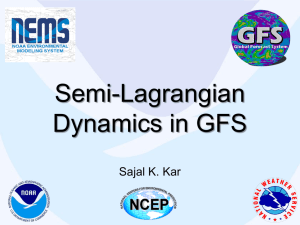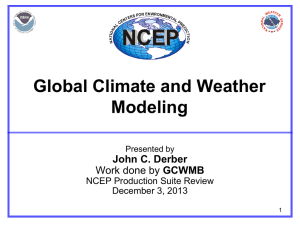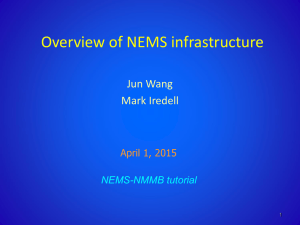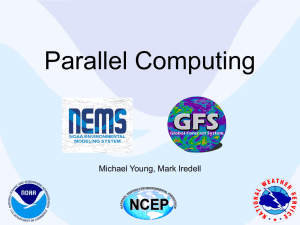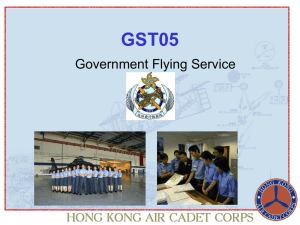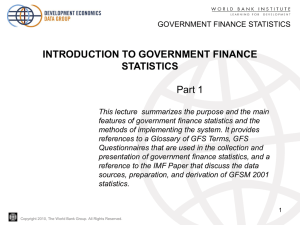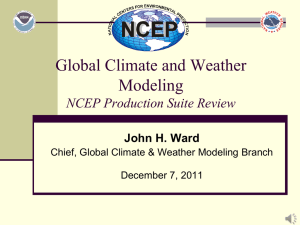nemsgfs_gwd_ja
advertisement
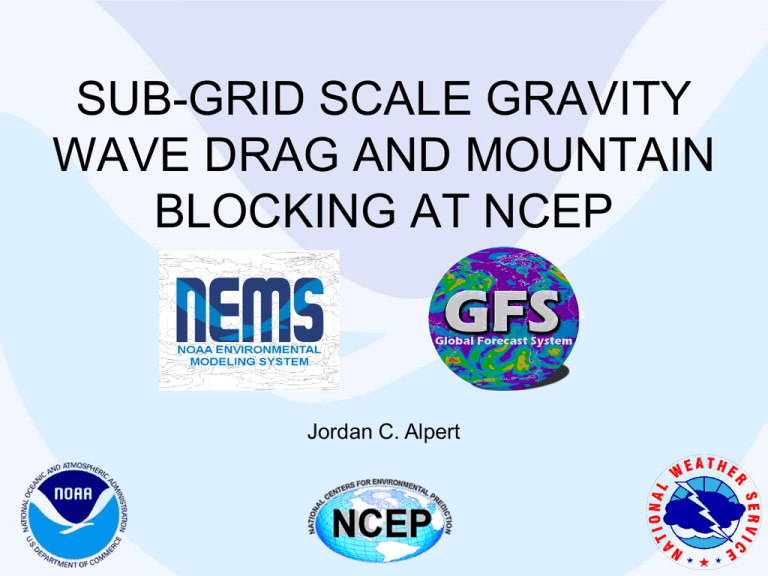
SUB-GRID SCALE GRAVITY WAVE DRAG AND MOUNTAIN BLOCKING AT NCEP Jordan C. Alpert Outline Mountain Blocking Orographic Gravity Wave Drag Convective Gravity Wave Drag NEMS/GFS Modeling Summer School 2 Correction of model bias from sub-grid scale parameterization is an on-going process. Atmospheric flow is significantly influenced by orography, creating lift and frictional forces. The representation of orography and its influence in numerical weather prediction models are necessarily divided into resolvable scales of motion and treated by primitive equations, the remaining sub-grid scales to be treated by parameterization. Orographic Gravity wave Drag, 1987, 1997 Mountain Blocking, 2004 Upgrade including Vertical Diffusion, 2005 Convective Gravity Wave Drag, 2014 NEMS/GFS Modeling Summer School 3 • Mountain blocking of wind flow around sub-gridscale orography is a process that retards motion at various model vertical levels near or in the boundary layer. • Flow around the mountain encounters larger frictional forces by being in contact with the mountain surfaces for longer time as well as the interaction of the atmospheric environment and vortex shedding which is shown to occur in numerous observations and tank simulations. • Snyder, et al., 1985, observed the behavior of flow around or over obstacles and used a dividing streamline to analyze the level where flow goes around a barrier or over it. NEMS/GFS Modeling Summer School 4 • Lott and Miller (1997) incorporated the dividing streamline into the ECMWF global model, as a function of the stable stratification, where above the dividing streamline, gravity waves are potentially generated and propagate vertically, and below, the flow is expected to go around the barrier with increased friction in low layers. • An augmentation to the gravity wave drag scheme in the NCEP global forecast system (GFS), following the work of Alpert et al., (1988, 1996) and Kim and Arakawa (1995), Mountain Blocking is incorporated from the Lott and Miller (1997) scheme with minor changes and including the dividing streamline. NEMS/GFS Modeling Summer School 5 • The idea of a dividing streamline at some level, hd, as in Snyder et al. (1985) and Etling, (1989), dividing air parcels that go over the mountain from those forced around an obstacle is used to parameterize mountain blocking effects. • Recent studies of model behavior have shown that models underestimate mountain drag. Further, the NWP models generate mountain disturbances which have horizontal scales that are the same as the model truncation. NEMS/GFS Modeling Summer School 6 U H hd l(z) Top View b model grid point a l(z) Fig 1. Representationof the low-level flow above and below the dividing streamline. NEMS/GFS Modeling Summer School 7 The dividing streamline height, of a sub-grid scale obstacle, can be found from comparing the potential and kinetic energies of up stream large scale wind and subgrid scale air parcel movements. These can be defined by the wind and stability as measured by N, the Brunt Vaisala frequency. The dividing streamline height, hd, can be found by solving an integral equation for hd: U 2 hd H N 2 z H z dz hd where H is the maximum elevation within the sub-grid scale grid box of the actual orography, h, from the GTOPO30 dataset of the U.S. Geological Survey. NEMS/GFS Modeling Summer School 8 In the formulation, the actual orography is replaced by an equivalent elliptic mountain with parameters derived from the topographic gradient correlation tensor, Hij: Hij h h xi x j and standard deviation, h'. The model sub-grid scale orography is represented by four parameters, after Baines and Palmer (1990), h', the standard deviation, and g, s, Q, the anisotropy, slope and geographical orientation of the orography form the principal components of Hij, respectively. These parameters will change with changing model resolution. NEMS/GFS Modeling Summer School 9 In each model layer below the dividing streamline a drag from the blocked flow is exerted by the obstacle on the large scale flow and is calculated as in Lott and Miller (1997): Dd z Cd l zU U / 2 where l(z) is the length scale of the effective contact length of the obstacle on the sub grid scale at the height z and constant Cd ~ 1. l(z) = F(z, hd, h‘, g, s, Q, Where Q , the geographical orientation of the orography minus the low level wind vector direction angle, . NEMS/GFS Modeling Summer School 10 The function l(z) according to Lott and Miller: (1) (2) (3) s hd z l z max2 1 / r,0 max cos , g sin 2h' z h' Term (1) relates the eccentricity parameters, a,b, to the sub-grid scale orography parameters (Fig. 1), a ~ h‘/s and a/b = g and allows the drag coefficient, Cd to vary with the aspect ratio of the obstacle, as seen by the incident flow, since it is twice as large for flow normal to an elongated obstacle compared to flow around an isotropic obstacle. Term (2) accounts for the width and summing up a number of contributions of elliptic obstacles, and Term (3) takes into account the flow direction in one grid region. NEMS/GFS Modeling Summer School 11 Some of the motivation for applying the sub-grid scale MB is models reduced bias and RMS errors by adding an orography enhancement such as enhanced mountains or “silhouette” mountains. Anomaly Correlation (NH 20-80N) skill for enhanced orography is shown for a low resolution experiment. But then the elevation of the models surface and interaction with observations became a problem. NEMS/GFS Modeling Summer School 12 NEMS/GFS Modeling Summer School 13 5 NEMS/GFS Modeling Summer School 14 NEMS/GFS Modeling Summer School 15 NEMS/GFS Modeling Summer School 16 NEMS/GFS Modeling Summer School 17 Orographic GWD vs Convective GWD Kim, Moorthi & Alpert’s vs Chun and Baik’s CGWD implemented by Ake Both based on linear, 2-D non-rotating, stably stratified Homogenous vs nonHomogenous flow NEMS/GFS Modeling Summer School 18 The existence of the QBO is due to wave-mean flow interactions in the tropical stratospheres. The waves that participate in these interactions, large scale Kelvin and Rossby-gravity waves as well as smaller scale internal gravity waves, all have non-zero phase speeds. Because of the importance of non-stationary gravity waves, not only for the QBO but also in general, a second class of parameterization schemes for GWDC has been developed where a gravity-wave spectrum is assumed which includes both stationary waves and waves of varying phase speeds. Next Steps: - Test non-orographic GWD spectrum (ECMWF and NCAR approach's are candidates) - Test sub grid scale effects from form drag (<5km) as in ECMWF - Merge GWD and CGWD subroutines (speed up of code) - Test including GWD contributions as additions to diffusion (in MONIN) (code speed up and enable reduction in diffusion) NEMS/GFS Modeling Summer School 19 Climatological mean of the tendency of the zonal mean zonal wind due to orographic gravity wave drag. Left panel is for boreal winter and right panel for boreal summer. Unit is dm/s/Day. Zonal mean of zonal wind tendency due to GWDC in units of cm/s/Day … from Ake’s presentation. Skill Score Experiment \ Season AC H500 NH AC H500 SH DEC-JAN JUL-AUG DEC-JAN JUL-AUG CNTR 87.0 81.3 84.1 80.0 GWDC2 87.4 81.4 83.9 79.9 GWDC2-CNTR 0.4 0.1 -0.2 -0.1 NEMS/GFS Modeling Summer School Skill scores for GWDC 20 Mountain Blocking: The Regional Spectral Model (RSM) has the same physical parameterization as the GFS but is run at 10 km resolution over Hawaiian islands so it is useful to compare simulations as a proxy for the events to be modeled. The RSM is initialized by the GFS which responds weakly to the presence of the barriers. By 21Z, 9-h later, the RSM (right) shows streamlines and wind barbs bending around the big island with a wind shadow on the lee side. The wind speeds show that 20 knot winds are reduced to near zero and reverse in the shadow zone. The surface pressure increases on the windward side and decreases on the leeward side and increased wind speeds are seen along the lateral sides of the barrier. The vorticity responds to the jets and soon sheds vortices down stream of the barrier. Note the similarity between the big Island and Maui, the closest but smaller island as the GFS is to theNEMS/GFS Modeling Summer School RSM. 21 Wind Difference (contours, [m/s]) of mountain blocking (MB) minus operational GFS from an average of 7 forecast experiments with independent cycling analysis of Observations. The model orography (“what the model sees”) is shown in Blue and the total wind is shown in Green vectors with a prevailing flow of ~12 m/s. The wind difference vectors are in Red (max 1 m/s): An east red vector indicates the wind is reduced in the experiment and a westward pointing red vector shows an increase in the MB wind. T254 NEMS/GFS Modeling Summer School 22 T62 NEMS/GFS Modeling Summer School 23 T254 with Mountain Blocking present. NEMS/GFS Modeling Summer School 24 Model skill scores at low resolution show impressive gains in anomaly correlation and RMS errors. The improvement in scores in low resolution experiments are not as large in the high resolution. Mountain Blocking is consistently an improvement. Periodically a number of runs are done to test calibration of the vertical diffusion and MB/GWD. NEMS/GFS Modeling Summer School 25 Orographic GWD vs Convective GWD Kim, Moorthi & Alpert’s vs Chun and Baik’s CGWD implemented by Ake Both based on linear, 2-D non-rotating, stably stratified Homogenous vs non-Homogenous flow NEMS/GFS Modeling Summer School 26 The existence of the QBO is due to wave-mean flow interactions in the tropical stratospheres. The waves that participate in these interactions, large scale Kelvin and Rossby-gravity waves as well as smaller scale internal gravity waves, all have non-zero phase speeds. Because of the importance of non-stationary gravity waves, not only for the QBO but also in general, a second class of parameterization schemes for GWDC has been developed where a gravity-wave spectrum is assumed which includes both stationary waves and waves of varying phase speeds. Next Steps: - Test non-orographic GWD spectrum (ECMWF and NCAR approach's are candidates) - Test sub grid scale effects from form drag (<5km) as in ECMWF - Merge GWD and CGWD subroutines (speed up of code) - Test including GWD contributions as additions to diffusion (in MONIN) (code speed up and enable reduction in diffusion) NEMS/GFS Modeling Summer School 27 Climatological mean of the tendency of the zonal mean zonal wind due to orographic gravity wave drag. Left panel is for boreal winter and right panel for boreal summer. Unit is dm/s/Day. Zonal mean of zonal wind tendency due to GWDC in units of cm/s/Day SLIDES taken from Ake’s presentation. Skill Score Experiment \ AC H500 SH DEC-JAN JUL-AUG DEC-JAN JUL-AUG CNTR 87.0 81.3 84.1 80.0 GWDC2 87.4 81.4 83.9 79.9 0.4 0.1 -0.2 -0.1 GWDC2-CNTR Season AC H500 NH NEMS/GFS Modeling Summer School Skill scores for GWDC 28
